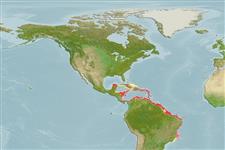Environment: milieu / climate zone / depth range / distribution range
экология
морской; солоноватоводный донно-пелагический; мигрирует в океане (Ref. 51243); пределы глубины 0 - 50 m (Ref. 189). Tropical; 23°N - 25°S, 90°W - 32°W (Ref. 189)
Western Atlantic: in the Antilles, from Cuba and perhaps throughout; Guatemala south and east to Venezuela and Trinidad, south to just north of Rio de Janeiro, Brazil).
Size / Вес / Возраст
Maturity: Lm ? range ? - ? cm
Max length : 30.0 cm TL самец/пол неопределен; (Ref. 37032); common length : 17.0 cm TL самец/пол неопределен; (Ref. 5217)
колючие лучи спинного плавника (общее число) : 0; колючие лучи анального плавника: 0; членистые (мягкие) лучи анального плавника: 25 - 32. Snout short and pointed, tip at about eye center; maxilla moderate, tip pointed and reaching onto pre-operculum (but not beyond), extending beyond second supra-maxilla; sub-operculum with angular hind margin, but not formed into a triangular projection; lower gill rakers increasing in large fishes. Anal fin origin below front few dorsal fin rays. Silver stripe disappearing with age (Ref. 189).
Found inshore forming quite large schools and also in estuaries, mangroves and other lagoons, penetrating into almost freshwater (salinities of 4.9-32.25 ppt in Santa Cruz Canal, Pernambuco, Brazil). Feeds by filtering plankton. No data on spawning.
Life cycle and mating behavior
половая зрелость | размножение | нерест | икра | Fecundity | личинки
Spawn in school (Ref. 205).
Whitehead, P.J.P., G.J. Nelson and T. Wongratana, 1988. FAO Species Catalogue. Vol. 7. Clupeoid fishes of the world (Suborder Clupeoidei). An annotated and illustrated catalogue of the herrings, sardines, pilchards, sprats, shads, anchovies and wolf-herrings. FAO Fish. Synop. 125(7/2):305-579. Rome: FAO. (Ref. 189)
Статус Красного Списка МСОП (Ref. 130435: Version 2024-1)
Угроза для людей
Harmless
Использование человеком
рыболовство: не имеет хозяйственного значения; наживка: usually
дополнительная информация
инструменты
Специальные отчеты
Скачать в формате XML
ресурсы в Интернет
Estimates based on models
Preferred temperature (Ref.
123201): 26.4 - 28.1, mean 27.5 °C (based on 172 cells).
Phylogenetic diversity index (Ref.
82804): PD
50 = 0.6250 [Uniqueness, from 0.5 = low to 2.0 = high].
Bayesian length-weight: a=0.00513 (0.00408 - 0.00645), b=3.17 (3.10 - 3.24), in cm total length, based on LWR estimates for this species (Ref.
93245).
Trophic level (Ref.
69278): 3.4 ±0.45 se; based on food items.
устойчивость к внешним воздействиям (Ref.
120179): высокий, минимальное время удвоения популяции до 15 месяцев (Preliminary K or Fecundity.).
Fishing Vulnerability (Ref.
59153): Low vulnerability (20 of 100).
Nutrients (Ref.
124155): Calcium = 127 [64, 285] mg/100g; Iron = 1.09 [0.58, 2.01] mg/100g; Protein = 18.1 [16.6, 19.7] %; Omega3 = 0.405 [0.204, 0.884] g/100g; Selenium = 53.2 [27.5, 113.0] μg/100g; VitaminA = 34.3 [8.5, 97.2] μg/100g; Zinc = 1.5 [1.0, 2.2] mg/100g (wet weight);
